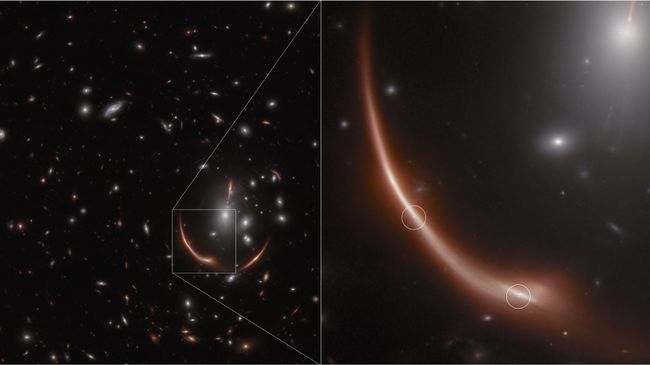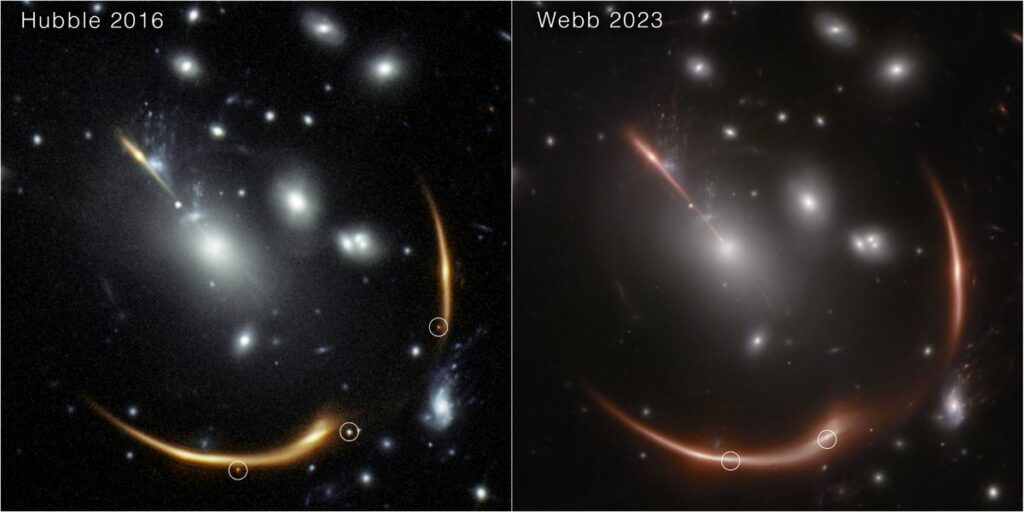James Webb Space Telescope Detects Distorted Supernova, Possibly Resolving an Ongoing Argument
We’ll have to wait until 2035 to get the conclusive answers once the last lensed images materialize.
Two distant supernovas within a galaxy, one observed as it existed 10 billion years ago, stand as crucial factors in unraveling the universe’s expansion rate, a topic causing a stir among scientists.
Captured by the Hubble and James Webb space telescopes, these supernovas reside in a galaxy revealed through gravitational lensing. This phenomenon occurs when massive entities, like a galaxy cluster, bend space to form a lens, magnifying and distorting light from more distant galaxies.

The galaxy MRG-M0138, imaged by the Hubble in 2016 but fully examined three years later, displays its light fragmented into five images by the gravitational lens of the cluster MACS J0138.0-2155, situated 4 billion light-years away. The resulting images, distorted into arcs, deviate from the typical appearance of galaxies due to this lensing effect.
Upon scrutinizing the Hubble images in 2019, astronomers identified the luminous signature of a type Ia supernova within MRG-M0138. These supernovas occur when a white dwarf undergoes a cataclysmic explosion, triggered by either colliding with another white dwarf or siphoning sufficient matter from a neighboring star.
Recently, using the James Webb Space Telescope (JWST), astronomers detected a second type Ia supernova in this remote galaxy. Dubbed “Encore,” this supernova accompanies the previously named “Requiem,” making MRG-M0138 the farthest galaxy where two type Ia supernovas have been observed. This discovery holds significant promise for resolving one of cosmology’s most perplexing enigmas.
The discrepancy in the measurement of the universe’s expansion rate, known as the Hubble constant, poses a challenge. Two conflicting values derived from different methodologies suggest a conundrum: either undetected measurement errors exist, or unconventional physics influences this phenomenon.
One method of determining the Hubble constant involves analyzing the cosmic microwave background (CMB) radiation, a remnant of the Big Bang. Variations in the CMB temperature correspond to ancient matter density fluctuations that shaped galaxies and clusters. Based on the standard cosmological model, these structures’ observed relationship allows astronomers to calculate a Hubble constant value of 67.4 kilometers (41.9 miles) per second per megaparsec. (To clarify, this means that within every second, a volume of space 3.26 million light-years wide expands by 67.4 kilometers.)

However, Type Ia supernovas play a crucial role in gauging cosmic distances and determining the Hubble constant. Their standardized maximum luminosity serves as a reference point for assessing their true brightness. By comparing their observed brightness to their intrinsic luminosity, astronomers estimate their distances. This comparison, alongside the supernova’s redshift indicating the rate of cosmic expansion, contributes to calculating the Hubble constant. This final calculation follows the Hubble–Lemaître law, equating recession velocity to distance multiplied by the Hubble constant. Utilizing this method, astronomers derive a value of 73.2 kilometers (45.5 miles) per second per megaparsec, surpassing the CMB-derived value.
Moreover, the lensed supernovas within MRG-M0138 offer a unique advantage, manifesting in five distinct images of the galaxy due to gravitational lensing.
“When a supernova explodes behind a gravitational lens, its light takes multiple paths to reach Earth,” explained Justin Pierel of the Space Telescope Science Institute and Andrew Newman of the Observatories of the Carnegie Institution for Science in a joint statement.
These paths vary in length, causing the supernova to appear in the images at different times, spanning days, weeks, or even years.
“By measuring the time differences in the appearance of supernova images, we can track the history of the universe’s expansion rate, or the Hubble constant, a significant challenge in modern cosmology,” stated Pierel and Newman.
Lensed supernovas are rare, with fewer than a dozen known instances, amplifying the exceptional value of the two type Ia supernovae in MRG-M0138. However, a complication arises: one of the light paths is projected to be considerably longer based on models of dark matter distribution in the lensing cluster. As a result, the final images aren’t anticipated until the mid-to-late 2030s.
“Normally, supernovas are unpredictable, but in this case, we have a timeline and location to anticipate the ultimate appearances of Requiem and Encore,” Pierel and Newman remarked. “Infrared observations around 2035 will capture their concluding moments and furnish a precise measurement of the Hubble constant.”
While the Hubble Space Telescope might not be operational by 2035, the hope rests on the James Webb Space Telescope (JWST). If active, and if it successfully detects the final images from Requiem and Encore, their Hubble constant measurement could resolve the question of whether the so-called Hubble tension results from experimental error or reflects a genuine phenomenon.
This article is republished from SpaceCom under a Creative Commons license. Read the original article.
Do not forget to share your opinion with us to provide you with the best posts !




0 Comments